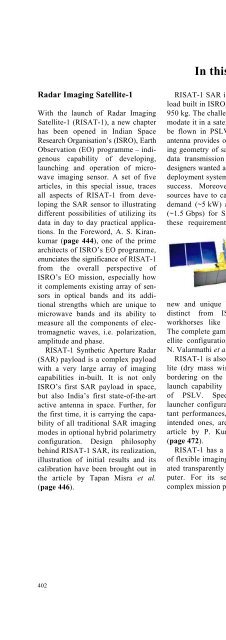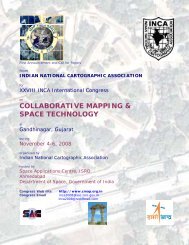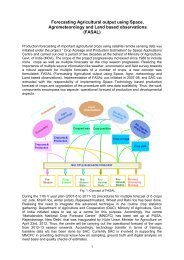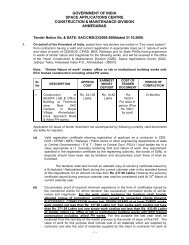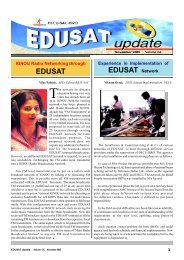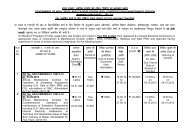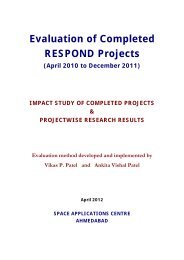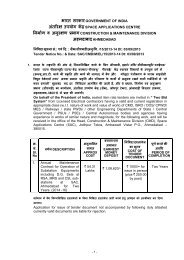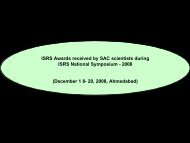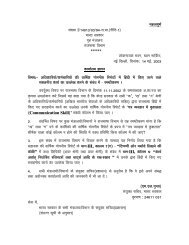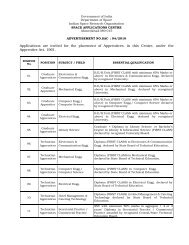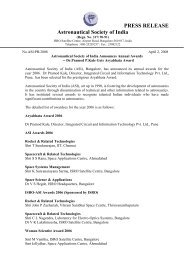Special Issue on RISAT-1, Current Science, 25 March 2013 - Space ...
Special Issue on RISAT-1, Current Science, 25 March 2013 - Space ...
Special Issue on RISAT-1, Current Science, 25 March 2013 - Space ...
- No tags were found...
You also want an ePaper? Increase the reach of your titles
YUMPU automatically turns print PDFs into web optimized ePapers that Google loves.
Radar Imaging Satellite-1With the launch of Radar ImagingSatellite-1 (<strong>RISAT</strong>-1), a new chapterhas been opened in Indian <strong>Space</strong>Research Organisati<strong>on</strong>’s (ISRO), EarthObservati<strong>on</strong> (EO) programme – indigenouscapability of developing,launching and operati<strong>on</strong> of microwaveimaging sensor. A set of fivearticles, in this special issue, tracesall aspects of <strong>RISAT</strong>-1 from developingthe SAR sensor to illustratingdifferent possibilities of utilizing itsdata in day to day practical applicati<strong>on</strong>s.In the Foreword, A. S. Kirankumar(page 444), <strong>on</strong>e of the primearchitects of ISRO’s EO programme,enunciates the significance of <strong>RISAT</strong>-1from the overall perspective ofISRO’s EO missi<strong>on</strong>, especially howit complements existing array of sensorsin optical bands and its additi<strong>on</strong>alstrengths which are unique tomicrowave bands and its ability tomeasure all the comp<strong>on</strong>ents of electromagneticwaves, i.e. polarizati<strong>on</strong>,amplitude and phase.<strong>RISAT</strong>-1 Synthetic Aperture Radar(SAR) payload is a complex payloadwith a very large array of imagingcapabilities in-built. It is not <strong>on</strong>lyISRO’s first SAR payload in space,but also India’s first state-of-the-artactive antenna in space. Further, forthe first time, it is carrying the capabilityof all traditi<strong>on</strong>al SAR imagingmodes in opti<strong>on</strong>al hybrid polarimetryc<strong>on</strong>figurati<strong>on</strong>. Design philosophybehind <strong>RISAT</strong>-1 SAR, its realizati<strong>on</strong>,illustrati<strong>on</strong> of initial results and itscalibrati<strong>on</strong> have been brought out inthe article by Tapan Misra et al.(page 446).In this issue<strong>RISAT</strong>-1 SAR is the heaviest payloadbuilt in ISRO, weighing close to950 kg. The challenge was to accommodateit in a satellite bus which canbe flown in PSLV. The large SARantenna provides obstructi<strong>on</strong> to viewinggeometry of satellite sensors anddata transmissi<strong>on</strong> systems. Further,designers wanted a simplified antennadeployment system which guaranteessuccess. Moreover, spacecraft resourceshave to cater to large powerdemand (~5 kW) and high data rate(~1.5 Gbps) for SAR operati<strong>on</strong>. Allthese requirements resulted into anew and unique bus c<strong>on</strong>figurati<strong>on</strong>,distinct from ISRO’s traditi<strong>on</strong>alworkhorses like IRS and INSAT.The complete gamut of <strong>RISAT</strong>-1 satellitec<strong>on</strong>figurati<strong>on</strong> is presented byN. Valarmathi et al. (page 462).<strong>RISAT</strong>-1 is also the heaviest satellite(dry mass wise) built in ISRO,bordering <strong>on</strong> the outer limit of thelaunch capability of highest versi<strong>on</strong>of PSLV. Specific PSLV XLlauncher c<strong>on</strong>figurati<strong>on</strong> and its resultantperformances, very close to theintended <strong>on</strong>es, are presented in thearticle by P. Kunhikrishnan et al.(page 472).<strong>RISAT</strong>-1 has a very large numberof flexible imaging capabilites, operatedtransparently by <strong>on</strong>-board computer.For its seamless operati<strong>on</strong>,complex missi<strong>on</strong> planning and operati<strong>on</strong>were built in ground c<strong>on</strong>trol ofspacecraft from ISTRAC, Bangalore.Further, ISRO’s data recepti<strong>on</strong> systemat NRSC, Hyderabad had to beupgraded by six folds from 110 to640 Mbps for <strong>RISAT</strong>-1 operati<strong>on</strong>.The data processing, archiving anddisseminati<strong>on</strong> system for <strong>RISAT</strong>-1had to be integrated in new IMGEOSfacility of NRSC. The heart of theground segment is a complex SARsignal processor, implemented inboth off line and near real time processingsystems at NRSC, to c<strong>on</strong>vertnoise like SAR signals to meaningfuldigital images with all the correcti<strong>on</strong>sand map projecti<strong>on</strong>s for disseminati<strong>on</strong>to users in user friendlyand universally acceptable data formats.All the facets of Ground Segment,as these activities are referredto in ISRO parlance, are presented inthe article by V. Mahadevan et al.(page 477).Ultimate aim of <strong>RISAT</strong>-1 programmeis to c<strong>on</strong>vert digital imagesto meaningful, user-specific geophysical,ecological and myriad otherapplicati<strong>on</strong> informati<strong>on</strong> so thatstrength of <strong>RISAT</strong>-1 data is harnessedby governmental agencies,commercial entities, global users, resourcescientists and general public.During the course of spacecraft’slifetime and bey<strong>on</strong>d, there is a possibilityof getting the data used formany different applicati<strong>on</strong>s, limitedby basic physics behind the radarsignal, its interacti<strong>on</strong> with earth elementsand ingenuity of resourcescientists. Very initial results, in thisendeavour, are presented in the articleby Manab Chakraborty et al.(page 490).402CURRENT SCIENCE, VOL. 104, NO. 4, <strong>25</strong> FEBRUARY <strong>2013</strong>


